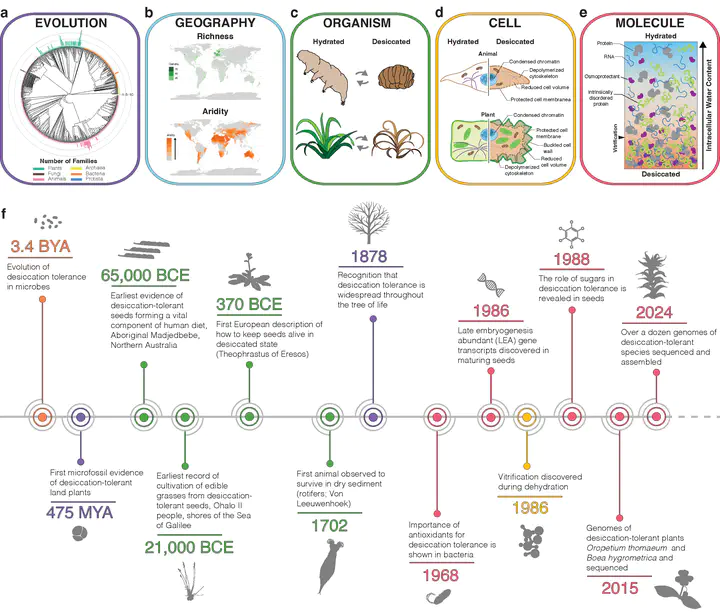Life on the dry side: a roadmap to understanding desiccation tolerance and accelerating translational applications
 Summaries of a evolutionary, b ecological, c morphological, d cellular, and e molecular aspects of desiccation tolerance. f timeline of major natural and research milestones in desiccation tolerance. Colors represent the biological scale of each discovery: purple for discoveries in evolution, blue for discoveries in geography, green for organismal-scale discoveries, yellow for cellular-scale discoveries, and red for discoveries on the molecular scale. Orange represents a historical biological event. For a brief history of the modern discovery of desiccation tolerance, see Alpert (2000). Illustrations in (c–e) by Rachel Torrez.
Summaries of a evolutionary, b ecological, c morphological, d cellular, and e molecular aspects of desiccation tolerance. f timeline of major natural and research milestones in desiccation tolerance. Colors represent the biological scale of each discovery: purple for discoveries in evolution, blue for discoveries in geography, green for organismal-scale discoveries, yellow for cellular-scale discoveries, and red for discoveries on the molecular scale. Orange represents a historical biological event. For a brief history of the modern discovery of desiccation tolerance, see Alpert (2000). Illustrations in (c–e) by Rachel Torrez.Abstract
To thrive in extreme conditions, organisms have evolved a diverse arsenal of adaptations that confer resilience. These species, their traits, and the mechanisms underlying them comprise a valuable resource that can be mined for numerous conceptual insights and applied objectives. One of the most dramatic adaptations to water limitation is desiccation tolerance. Understanding the mechanisms underlying desiccation tolerance has important potential implications for medicine, biotechnology, agriculture, and conservation. However, progress has been hindered by a lack of standardization across sub-disciplines, complicating the integration of data and slowing the translation of basic discoveries into practical applications. Here, we synthesize current knowledge on desiccation tolerance across evolutionary, ecological, physiological, and cellular scales to provide a roadmap for advancing desiccation tolerance research. We also address critical gaps and technical roadblocks, highlighting the need for standardized experimental practices, improved taxonomic sampling, and the development of new tools for studying biology in a dry state. We hope that this perspective can serve as a roadmap to accelerating research breakthroughs and unlocking the potential of desiccation tolerance to address global challenges related to climate change, food security, and health.